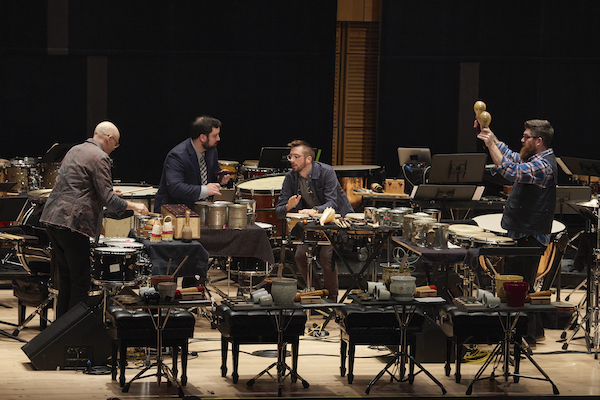Drums Along 7th Avenue: Wolfe premiere highlights Sō Percussion’s century survey

The revolutions in harmony, tonality, and form in 20th century music are so important that it’s common to overlook those of practice and instrumental techniques.
And the most important development in instrumental usage over the last 100 years has been the rise of the percussion ensemble. Developed by Mahler as a complete orchestral section, percussionists were liberated into autonomy in the main by Edgard Varèse via his Ionisation.
Naturally, Sō Percussion’s Saturday night dip into what they pointed out was the preceding 86 years of percussion music opened with Varese’s masterpiece.
Held in Zankel Hall, this terrific evening was not only a demonstration of some of the pinnacles of percussion music, but also a model of how to program a concert. Beginning with Ionisation, from the early 1930s, Sō played music as recent as this year, and divided up eras and styles into meaty slabs.
The quartet—Eric Cha-Beach, Josh Quillen, Adam Sliwinski, and Jason Treuting—were joined by up to nine other players to fill out the forces needed for the Varese and music by Carlos Chavez, Johanna Bryer, and Iannis Xenakis. With all the players on stage like an orchestra, the program segued immediately from Ionisation to the Largo from Chavez’s Toccata for Percussion Instruments, to Bryer’s March for 30 Percussion Instruments, through John Cage’s Third Construction—which ends with such an emphatic concluding statement that it was a natural spot for a break and applause.
This first segment was immersive. Ionisation is so canonic, one often misses its pathbreaking experimentalism, Varèse tossing elements together with a catalyst to see what ignites. Saturday night it was a simmering intensity, with the playing indulging in all the evocative darkness and mystical sonic alchemy. The quartet played Third Construction with great vitality and swing. From 1941, it sounded like a perfect capstone to the decade before that saw an explosion of percussion music, much of it among the finest in the repertoire.
That repertoire includes Xenakis monumental Pleiades. Sō played the final movement, “Peaux,” a churning, muscular construction via rhythms in time. This was exciting, driving playing, the Sō quartet and percussionists Todd Meehan and Doug Perkins playing with precision and a desire to push the music to the edge.
The first half ended with a vast contrast, the delicate, modest-seeming beauty of “part 3” of David Lang’s the so-called laws of nature. Primarily for tea cups and tuned flowerpots, the music has a gorgeous sound built on the underlying tension that came from the care the musicians must take to make their instruments sing and ring without shattering them.
The chiming sounds underlined how much of the music had been primarily about timbre, less so rhythm. That itself was the fundamental breakthrough that Mahler and Varèse had launched, culminating in the household items used for Third Construction and “part 3.”
Though one relished the extent to which the program eschewed the stale rituals of the classical concert hall—whenever there was a break between the pieces, Treuting spoke to the audience about the nature of the music—there was a massive amount of instruments that needed to be cleared for the second half. But the music continued in its own way, with a performance of Steve Reich’s Clapping Music in the crowded lobby during intermission.
Sō played two substantial works for the second half, “120bpm” from Dan Truman’s neither Anvil nor Pulley and the New York premiere of Julia Wolfe’s new Forbidden Love.
“120bpm” unfortunately fell flat. Neither Anvil nor Pulley is an album-length work (recorded on Canteloupe Records) and very much worth several listens. But the excerpt suffered from a lack of context, even the competing context of the fully sensual first half. The music is built around the abstract concept of the musicians competing against a metronome—and adds video game controllers to the myriad array of instruments—which was a misfit for the frame of sound and timbre and pulse the first half built. Truman’s piece was commissioned and crated for Sō Percussion, but it deserves to be heard as a whole.
Forbidden Love is also music written for Sō, and co-commissioned by Carnegie Hall. As Treuting introduced it, it’s also Wolfe’s String Quartet No. 5—the instrumentation is two violins, viola, and cello–but no bows. The percussionists used things like sticks and bare hands, with techniques that included ripping a stick from between the strings and the fingerboard, which set the string vibrating, and gently stroking the back of the instruments with bare hands.
The music was dreamy at first, a series of resonating and decaying shimmers from the open strings. As it went on, it built a few different rhythmic profiles, laid out in several discrete sequences. There was no clear form but it didn’t need one, this was a set of actions, each mysterious and set in an evocative repose. Pitch was important in the sense that the strings created a mass of bright harmonies that leaned toward just intonation.
But this wasn’t any kind of experimentation. As the musicians played the instruments like they were hammered dulcimers, one heard a surge of human traditions—the sound had a bluegrass quality, but the players, synchronized, got at the very origins of music making in human development. This was a stunning experience, and one felt that in an already marvelous career, with Forbidden Love Julia Wolfe has given us one of her most extraordinary works.
Kronos Quartet plays music by Terry Riley, Micheal Gordon, Steve Reich, and others, 9 p.m. January 25. carnegiehall.org






